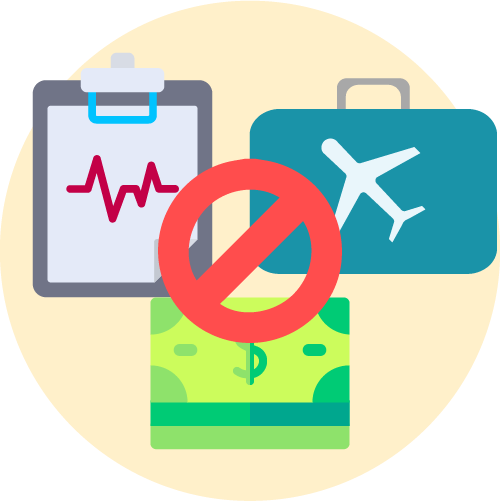- The gig economy has been around for decades; however, it became more widespread during and after Great Recession of 2008 as unemployment rates increased and as technological advances made it easier for professionals to find “gigs”.
- Gig workers enjoy the flexibility that the gig economy provides, and they report being more satisfied with their professional lives when compared to their traditional employee counterparts. However, there are disadvantages to gig work, mainly that it leaves workers unprotected.
- The gig economy is here to stay, but companies and governments will need to pass new laws and regulations that can help protect gig workers.
The gig economy is made up of independent contractors and freelancers that perform “gigs”—temporary and flexible jobs—for a variety of clients. Among the top reasons why professionals choose to be gig workers are:
- Flexible work hours
- Extra income
- Variety of work.
Prior to the COVID-19 pandemic, the U.S. gig economy was growing. Research from ADP Research Institute published in February of 2020 found that “from 2010 to 2019, the share of gig workers in companies has increased from 14.2% to 16.4%, a 2.2. percentage point increase, or 15%.”
The same research predicted that gig work would only continue to grow in the years to come. And then the pandemic hit.
A 2019 report from MetLife found that “almost 30 million Americans get their primary income from gig work, constituting nearly a fifth of the total workforce.” The report also found that 15 million traditional workers supplement their full-time jobs with gigs.
Like many other parts of the economy, the gig economy was impacted by the coronavirus pandemic. Companies began to furlough employees—who then searched for side gigs to have some income—and they also focused on cutting costs—which included measures like freezing hiring, postponing projects, and reducing hours.
Despite the setback caused by the COVID-19 pandemic, many argue that the gig economy is here to stay. And while this could be a good thing for some, the gig economy also presents its own set of challenges.
What Is the Gig Economy?

Although the term “gig economy” wasn’t coined until 2009, gig work has been around for decades; think of project-based contractors and seasonal and temporary workers (e.g. childcare, housekeeping, plumbers, seasonal workers, etc.). However, technological advances from 2008 onwards have made it easier than ever for workers to find gigs and for companies or individuals to find the right talent for specific projects.
Gig workers tend to go by different names, according to the ADP research. The following terms are often used to define a gig worker:
- Consultant
- Freelancer
- Free agent
- Contingent worker
- Self-employed
- Project-based worker.
Similarly, the gig economy is also often called:
- On-demand economy
- Sharing economy.
The gig economy and tech-enabled platforms that allow workers to search for “gigs” has created income generating opportunities for people that were previously outside of the labor market.
How Does the Gig Economy Work?
It’s pretty straightforward.
Rather than being a full-time employee of a company, gig workers tend to work on projects or short-term assignments for a variety of clients; they also work independently—meaning they aren’t in a company’s payroll. Most gig workers today find gigs through online platforms or apps, like Fiverr or Upwork.
What Is a Gig Job?
It can be a myriad of things.
For example, a graphic designer sees a posting for a project with Company XYZ, she applies for the job, negotiates her rates, and once the project is complete, she moves forward to the next client. Similarly, a writer may be hired to work on a short-term, specific project like writing website copy, and that’s as far as the relationship with a company goes.
While a gig job can certainly be something like the above, where contracts, hours, and remuneration are negotiated, a gig job can also be:
- Being an Uber of Lyft driver
- Offering plumbing services
- Being a delivery person for Deliveroo, GrubHub, etc.
- Babysitting
- Cleaning jobs.
While many gig jobs are short-term, requiring less than 3 months to complete, there are various gig jobs that require longer-time commitments of 6 months or more. Some gig workers go on to have long-lasting relationships with some clients.
The Rise of the Gig Economy
While gig jobs have existed for a long time, the gig economy boomed in the mid 2000s. According to experts, the uptick in gig jobs came after the Great Recession hit; as unemployment rates climbed. Out of necessity, people began to work any job they could get, including temporary ones.
At the time—and still today—this type of arrangement was attractive for professionals and companies alike. For workers, gig jobs allowed them to have some sort of financial security in uncertain times or have access to extra income; for companies, it allowed them to hire talent without having to employ anyone and incur on the associated costs (hiring and onboarding, training, health insurance, etc.).
Examples of Gig Jobs
Some gig jobs can be remote gig jobs—I.e., gig jobs done from home or a coworking space—others may require you to work on-site.
Let’s take a look at some gig job examples—online gig jobs and in-person ones.
- Accountant
- Independent lawyer
- Writer
- Marketer
- Handyman or handywoman
- Driver
- Programmer
- Plumber
- Electrician
- Caregiver
- Pet sitter
- Personal shopper
- Mover
- Transcriber
- Translator / interpreter
- Artist
- Photographer
- Designer
- Independent caterer
- Social media manager
- Home sharing.
While there certainly are a variety of gig jobs, not all gig jobs pay well—or equally as well. Here are the top 5 gig jobs that pay the most.
- Programming / coding
- Consulting jobs
- Project manager
- Photography
- Bookkeeping
According to The ADP Research Institute, gig workers in the recreation, construction and business services tend to be the best paid. On the other hand, gig workers in the education and information sector—media, broadcasting, telecommunications, printing and research—aren’t paid as well because these types of jobs “attract many low-paid freelancers”.
The Best Platforms to Find Gig Jobs Near You and Remote
- Upwork

- Fiverr

- Toptal

- FlexJobs

- TaskRabbit

- Care.com

- 99 designs

- Freelancer

- Guru.

The Gig Economy and Its Impact on Workers
While the gig economy provides various benefits and advantages to gig workers, the reality is that gig workers have one main disadvantage over traditional employees:
They are less protected.
But before we dive into this, let’s take a closer look at the advantages of being a gig worker.
Advantages of Gig Work

Research has found that, contrary to popular belief, gig workers work independently by choice, not by necessity.
The MetLife report found that 20% of full-time employees have a secondary job, with 49% of those employees having plans to leave their current employer for contract or freelance work in the next five years.
85% of surveyed gig workers plan to continue in this line of work in the next five years, according to the report.
On a similar note, ADP found that 60% of gig workers plan to continue to gig for the next three years.
Why?
For a variety of reasons, though the main driver seems to be flexibility.
Flexibility
Flexibility seems to be the main motivator for gig workers; so much in fact that many place a premium on flexibility over financial security or corporate benefits.
MetLife found that 3 in 4 gig workers say being an independent worker provides them the flexibility they need to better manage their personal and work lives.
This flexibility allows gig workers to:
- Set their own schedules
- Manage their workload depending on their needs
- Pursue projects that interest them
- Work wherever they want.
Sense of Fulfillment
Because gig workers can handpick the projects they want to work on, they tend to choose work that fulfills them. They typically are able to pursue work in areas they are passionate about, and this is in fact one of the main reasons why gig workers want to continue “gigging”:
Gig work allows them to pursue their passions and interests.
Just as many workers leave their traditional roles for more flexibility, others leave their full-time employment status for gig work in order to gain a sense of fulfillment.
Studies have found that gig workers are more satisfied than their full-time counterparts, with 79% of full-time gig workers saying they were happier working on their own than at a traditional job.
Greater Variety
This applies in two main ways:
- Variety of projects
- Variety of sources of income.
Because they are not full-time employees for a specific company, gig workers are able to work on a variety of projects within their line of work. This means that a writer may be writing content for a travel magazine, for an HR blog, for a new corporate website, or for a political campaign. A programmer may be working on coding for a website or a mobile app.
Because of this variety in clients and projects, gig workers are able to set up multiple sources of income; they have different clients, with different deadlines.
An important thing to note is that gig workers can charge in a variety of ways, depending on the work they are hired to do. For example, for one project it may make more sense to charge per hour, while for another it may make more sense to charge for the entire project.
Drawbacks of Gig Work

Gig workers make some compromises when they choose gig work over traditional employment.
Lack of Access to Benefits and Perks
This is probably one of the main reasons why gig workers where in a particularly vulnerable situation during the COVID-19 pandemic.
Because gig workers are considered independent contractors or freelancers, they do not have access to company sponsored perks and benefits like:
- Paid sick leave
- Vacation time
- Health insurance
- 401Ks
- Company sponsored meals
- Travel vouchers.
Research has also found that gig workers feel they miss out on networking opportunities that naturally happen in full-time, office work.
Less Job Security and Financial Instability
Gig workers fully depend on demand for the services they provide; if that demand dries up, so does their income. In times of crisis, like the one created by the COVID-19 pandemic, gig workers are more likely to lose their “gigs” and experience a significant decline in demand for their services.
This means that many gig workers could potentially be left with no active source of income, which affects their job security and their financial stability. A study found that gig workers are more anxious about their finances, with 45% of full-time gig workers having a high economic anxiety index score, compared to 24% of traditional full-time employees.
On a similar note, research found that in the US, 80% of freelancers whose primary source of income is from the gig economy would have difficulty paying an unexpected $1,000 expense.
Independently Handly Taxes
Unlike their payroll counterparts, gig workers will have to pay their taxes independently; their companies will not remove taxes from the paycheck.
This means that gig workers have to factor in taxes in their rates and they have to plan to file their tax forms in advance.
Similarly, gig workers are also responsible for any personal expenses they may incur while working—phone, laptop, supplies. These can often be written off for tax purposes, but it’s not always easy for gig workers to know what to deduct.
Many gig workers find that working with an accountant is the best course of action to ensure they are filing taxes correctly and that they are writing off everything that applies in their specific case.
Private Health Insurance
Since gig workers do not have access to company sponsored benefits, like health insurance, they need to pay for it out of pocket. MetLife found that only 4% of gig workers report their employer offers medical insurance.
Isolation
Gig workers, especially those in professional services, tend to work by themselves. As a result, many often report feeling lonely and isolated, as they miss out from the social element of office life.
To combat this, many gig workers tend to work out from coworking spaces where they find opportunities to network and mingle with other professionals.
The Future of the Gig Economy

The gig economy is here to stay.
It is estimated that the global gig economy will be worth $347 billion in 2021. What’s more, the global gig economy is expected to grow to $455 billion in 2023.
Deloitte found that there are currently 57 million gig economy workers, accounting for 36% of the US workforce. This percentage is expected to increase; by 2027, Deloitte expects the alternative workforce to become the majority of the US workforce.
Gig jobs are becoming more widespread as more professionals choose to leave their full-time jobs to have the flexibility offered by the gig economy, and as more companies offer gig job opportunities.
The key motivators for professionals seem to be flexibility and doing what they enjoy. For companies, the main drivers for hiring gig workers are having access to a larger talent pool and lower costs associated with HR.
Companies Need to Step up
Gig workers are good for business; they allow companies to have access to highly skilled talent and they allow for business to become more agile, especially in the face of economic crisis.
Specifically, Deloitte found that gig workers tend to update their skills more frequently than their traditional full-time counterparts because “their long-term success is dependent on staying up-to-date and minimizing time to delivery.”
Case in point, in 2019 60% of gig workers participated in a skills or education related training, compared with 40% of the traditional workforce. Companies that leverage gig workers can, therefore, attract highly skilled talent in a tight labor market.
However, companies need to step up their game to attract highly skilled gig workers, especially in professional fields where there is workforce saturation, like programming and web design.
Below are some strategies that can help companies attract gig workers:
- Focus on your branding and what employees say about working for you.
- Have a strong onboarding strategy that clearly sets out expectations.
- Include gig workers in all project-related communications. This means if you have a Slack channel dedicated to the project with full-time employees, you need to add gig workers to it as well, even if only temporarily.
- Offer constructive feedback. Feedback is key for gig workers, as it can help them improve their work and can help identify areas for improvement.
Changing Laws and Regulations
As the gig economy has grown, many have voiced complaints about compliance issues and companies misclassifying workers in order to avoid paying taxes and other associated costs—the most well-known example of this is Uber and Lyft drivers.
The gig economy will undoubtedly change the economic landscape of countries—to a certain extent, it already is. Countries need to prepare for this and pass laws and regulations that offer more protection to gig workers.
The gig economy presents many challenges for workers, like fair pay, access to health insurance, and PTO; those who work with clients all over the world also must add tax regulations to their list of concerns. While some governments are already taking regulatory steps to tackle some of these issues, there is more that needs to be done.
In a recent HBR article, Alex Rosenblat writes that:
“[T]he longer-term solution to fissured or sub-contracted workplace relationships — as well as other threats to formal employment, such as automation — is to shift certain costs of employment from employers onto society at large. Instead of pushing gig employers to reclassify their workers (which is unlikely to be successful on a national scale, given the significant financial disincentives in place), we should think more broadly about delinking healthcare, unemployment insurance, and other vital benefits from specific forms of employment, while providing a protective labor standard for all workers that includes collective bargaining (even for self-employed workers), OSHA, and other workplace rights.”
Companies will need to work together with their local governments for these changes to happen. These changes will provide gig workers with more stability, and it will protect them during challenging times.
An Opportunity for Flexible Space Operators
If more professionals are expected to become gig workers in the future, then there will likely be an increased demand for flexible office space. Gig workers don’t have the need to rent office space full-time; however, they still have need for office space.
Gig workers have been one of the main users of flexible workspace solutions over the past decade, while corporate use of these spaces is expected to rise in the future, the main users of these types of spaces will continue to be gig workers that are searching for a place to network and bond with like-minded individuals.
Flex space operators need to take this into consideration when planning their expansion and growth. As the world moves from work from home to work near home, operators that expand into suburban areas, close to where people live, stand to gain the most.
Conclusion
The gig economy is here to stay, with the number of gig workers expected to rise significantly through 2027.
While the gig economy offers a plethora of opportunities—flexibility, extra income, increased job satisfaction, business agility, and larger labor market—it also presents serious challenges that need to be addressed by workers, employers, and governments.
Companies need to learn to navigate the compliance issues associated with hiring gig workers and explore new ways to better engage with the non-traditional workforce.


 Dr. Gleb Tsipursky – The Office Whisperer
Dr. Gleb Tsipursky – The Office Whisperer Nirit Cohen – WorkFutures
Nirit Cohen – WorkFutures Angela Howard – Culture Expert
Angela Howard – Culture Expert Drew Jones – Design & Innovation
Drew Jones – Design & Innovation Jonathan Price – CRE & Flex Expert
Jonathan Price – CRE & Flex Expert













